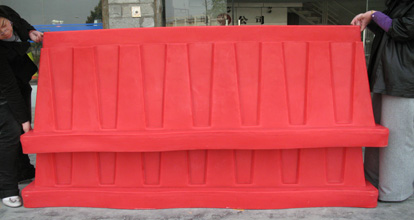The Benefits of Rotational Moulding in Polyethylene Barriers (Part 1 of 2)
Part 1 of 2
Rotational moulding is a production process that involves a heated hollow mould which is filled with a certain quantity of plastic, then slowly rotated in order for the melted material to disperse and stick to the walls of the mould. The rotation continues in the cooling stage, after which the mould can be opened to retrieve a complete hollow plastic object with walls of even thickness. This method has found many applications in industrial processes among them in the production of superior quality plastic barriers.
In this 2-part article we will look into the effects of weather elements on plastic, especially in the context of the South Pacific and New Zealand climate, and continue to elaborate on the counteracting effects of rotational moulding or rotomoulding and its application in water filled barriers. First of all, in order to better understand the importance of rotomoulding on exterior use plastics such as water filled barriers we need to look into the effects weathering factors can have on plastic.
Sunlight and humidity take a toll on appearance
The first symptom of weathering is visible in the colour that will soon start fading and yellowing due to the chemical reactions caused by sunlight and oxygen. To be more specific, what really damages plastic is not sunlight per se but solar radiation or UV light that initiates a destructive reaction on polymer chains, making plastic become brittle over time.
In humid climates in particular, this is usually accompanied by the polymer chain scission resulting in slow erosion and roughening of the plastic’s smooth surface. This starts a domino effect with underlying layers beginning to erode in turn and losing pigment as they are exposed to the elements. Appearance wise this means that the plastic will lose its initial glossy colour since light no longer reflects on a smooth surface. Rather it scatters looking faded and worn out.
Fluctuating temperatures make matters worse
Weather cycles and extreme weather variations from wet to dry and hot to cold and vice versa will also take their toll on plastic causing it to continually shrink and swell, and triggering a cracking of the surface. The latter, apart from affecting appearance, will also have an impact on the plastic’s mechanical properties such as tensile and impact strength and thickness.
Temperature alone can have a devastating effect on plastic causing a dramatic doubling of the breakdown process whenever the thermometer rises by 10 degrees C. Now, imagine all those factors combined – as is the case in real life conditions – and you can clearly see the amount of stress exerted on outside plastics that can accelerate normal weathering. This seen in the context of the South Pacific and New Zealand climate, where the combined effect of high UV and humidity levels is much more prominent, means bad news for plastic components that have to be exposed to the weather elements all year round.
Continue reading part 2 of the article, where we will see how this affects polyethylene barriers that are meant to be exposed to the elements for long periods and, most importantly, how we can counteract and significantly slow down the breakdown process.










